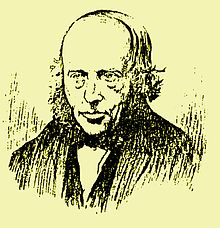Robert Davidson (inventor)
Robert Davidson | |
|---|---|
 | |
| Born | 1804 Tarbolton, South Ayrshire, Scotland |
| Died | 1894 (Age: 90) |
| Nationality | Scottish |
| Occupation | civil engineer |
| Known for | Built the first known electric locomotive. |

Robert Davidson (1804–1894) was a Scottish inventor who built the first known electric locomotive in 1837. He was a lifelong resident of Aberdeen, northeast Scotland, where he was a prosperous chemist and dyer, amongst other ventures. Davidson was educated at Marischal College, where he studied second and third year classes of Marischal College from 1819-1821,[1] including lectures from Professor Patrick Copland. He got this education in return for being a lab assistant.
In the 1820s he set up in business close to the Aberdeen-Inverurie Canal, at first supplying yeast, before becoming involved in the manufacture and supply of chemicals.[1]
He became interested in the new electrical technologies of the day. From 1837, he made small electric motors on his own principles, though William H. Taylor in the US made similar motors from 1838. Both men worked independently without knowledge of the other's work.
Exhibitions[]
Davidson staged an exhibition of electrical machinery at Aberdeen, Scotland, and in Edinburgh where it was viewed on February 12, 1842, by the young James Clerk Maxwell.[2]
Later he exhibited at the Egyptian Hall in Piccadilly in London, where he hoped to attract sponsorship for his work.[1] Among the machines shown were his locomotive, an electrically driven lathe and printing press, and an electromagnet capable of lifting 2 tons.[3]
Electric locomotives[]
Davidson made a model electric locomotive in 1837. His Galvani of 1842 was a four-wheeled machine, powered by zinc-acid batteries. It was tested on the Edinburgh-Glasgow line in September 1842 and, although found capable of carrying itself at 4 mph, it did not haul any passengers or goods.[4]
Davidson's legacy[]
He has been described as a forgotten hero and electrical visionary.[3] He could not interest the rail companies; the technology he employed was too expensive.[1]
In 1840, the Aberdeen Banner had predicted that the type of machinery he was producing "will in no distant date supplant steam"; however, it was only when electric locomotives were introduced in the 1890s that the media came to recognize what he had done. He was described as the "oldest living electrician" and The Electrician magazine reported " Robert Davidson was undoubtedly the first to demonstrate the possibility of electrical traction in a practical way".[3]
A working model of his electrical motor can be seen at the Grampian Transport Museum.
Business[]
After 1843, at home in Aberdeen, he settled down to family life and, for the next fifty years, the running of his business at Canal Road. His earlier invention of a method for large-scale production of yeast, one of the staples of his chemical business,[5] and the manufacture of perfumes were so remunerative that it allowed him to indulge his many interests of astronomy, collecting of fine china, valuable pictures and a large collection of violins.
See also[]
References[]
- ^ a b c d John S. Reid Robert Davidson — pioneer electrician from Natural Philosophy Museum, University of Aberdeen
- ^ Anthony F. Anderson (11 June 1981) Forces of Inspiration, The New Scientist, pages 712,3 via Google Books
- ^ a b c John S. Reid (2007). "Scottish Scientific Heroes from the East Coast" (PDF). University of Aberdeen. Natural Philosophy Museum, University of Aberdeen. p. 8. Retrieved 24 February 2016.
- ^ Gordon, William (1910). "The Underground Electric". Our Home Railways. 2. London: Frederick Warne and Co. p. 156.
- ^ Day, Lance; McNeil, Ian (1966). "Davidson, Robert". Biographical dictionary of the history of technology. London: Routledge. ISBN 978-0-415-06042-4.
Further reading[]
- The Practical Mechanic Vol II, November 1842 pp 48–51.
- J.H.R. Body, "A Note on Electro-Magnetic Engines", Newcomen Society Transactions: 14: 103–107.
- Robert C. Post (1974) "Electro-Magnetism and Motive Power: Robert Davidson's "Galvani" of 1842", Railroad History, pages 5–23.
- A.C. Davidson (January 1976) "An Ingenious Aberdonian", The Scots Magazine
- John R. Stevens (editor) (1989,90) Pioneers of Electric Railroading: Their Story in Words and Pictures, Chapter 1, pages 1 – 6, published by The Electric Railroader's Association
- John Aspinall (1909) Presidential Address to the Institution of Mechanical Engineers (appendix) includes extract from Railway Times, 10 December 1842.
- 1804 births
- 1894 deaths
- Scottish inventors
- People from Aberdeen
- Alumni of the University of Aberdeen
- Scottish railway mechanical engineers
- British railway pioneers
- Sustainable transport pioneers
- 19th-century British businesspeople